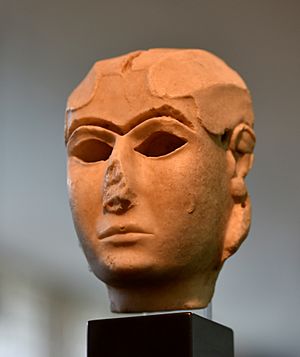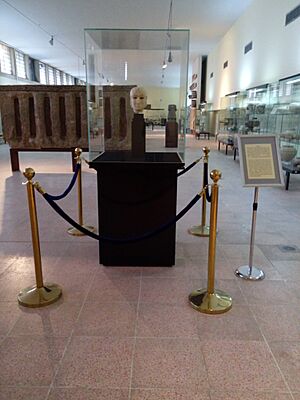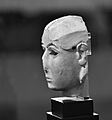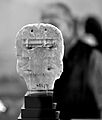Mask of Warka facts for kids
Quick facts for kids Mask of Warka |
|
|---|---|

Mask of Warka, National Museum of Iraq
|
|
| Material | Marble |
| Height | 21.2 cm |
| Created | c. 3100 BC |
| Discovered | 22 February 1939 Muthanna, Iraq |
| Present location | Baghdad, Baghdad Governorate, Iraq |

The Mask of Warka, also known as the Lady of Uruk, is a very old carved face made of marble. It was found near the ancient city of Uruk in Iraq. This mask is special because it is one of the first known artworks to show a human face accurately. It was made around 3100 BC, which means it is over 5,000 years old!
The mask is about 21.2 centimeters (8.3 inches) tall. Experts believe it might show the goddess Inanna. It was probably part of a bigger statue, perhaps made of wood. Today, you can see the Mask of Warka in the National Museum of Iraq in Baghdad. It was safely returned after being taken during the Iraq War in 2003.
The eyes of the mask might have been made from shells for the white parts. The pupils, which are the dark centers of the eyes, might have been made from a beautiful blue stone called lapis lazuli.
Contents
What the Mask Looks Like
The Mask of Warka is unique because it shows a human face in a very real way. Earlier artworks of faces, like the Tell Brak Head, often had features that were not quite right, such as very big noses or ears.
This mask was likely part of a full-sized statue. The main part of the statue was probably made of wood. Only the parts that looked like skin, such as the face, arms, hands, and feet, were made from rare white marble. The back of the mask was flat. It had small holes, which means it was attached to something else.
The back of the head was probably covered with a sticky material called bitumen. Then, colored metal, like gold or copper, was placed over it. This metal might have looked like wavy hair. Small metal studs could have held this hairpiece in place. The hollow parts for the eyes and eyebrows show signs of old inlays. These might have been made from shells and lapis lazuli. There are also holes in the ears, which suggest the statue once wore jewelry.
How the Mask Was Found
The Mask of Warka was discovered on February 22, 1939. A team of archaeologists from Germany found it. They were led by Dr. A. Nöldeke. The mask was found in the ancient city of Uruk, which is south of modern Baghdad.
It was found in a part of the city called the Eanna district. This area was named after the goddess Inanna, to whom the temples there were dedicated.
The Mask's Journey and Return
In 2003, during the Iraq War, the National Museum of Iraq was broken into. Many valuable items were taken, including the Mask of Warka. It is believed the mask was taken between April 10 and 12 of that year. Other important items, like the Warka Vase and the Bassetki Statue, were also taken.
A team led by Colonel Matthew Bogdanos worked hard to find these lost artifacts. On April 21, they started their investigation. The Mask of Warka was found just before October by the 812th Military Police Company.
An Iraqi person told the investigators where some old items were hidden. The team went to a farm in northern Baghdad. At first, they did not find the mask. But after talking to the farmer, he admitted he had buried it in his farm. The investigators went behind the farm and found the mask exactly where he said it was. It was still in perfect condition and undamaged.
See also
- Art of Mesopotamia
- Warka Vase
Gallery






